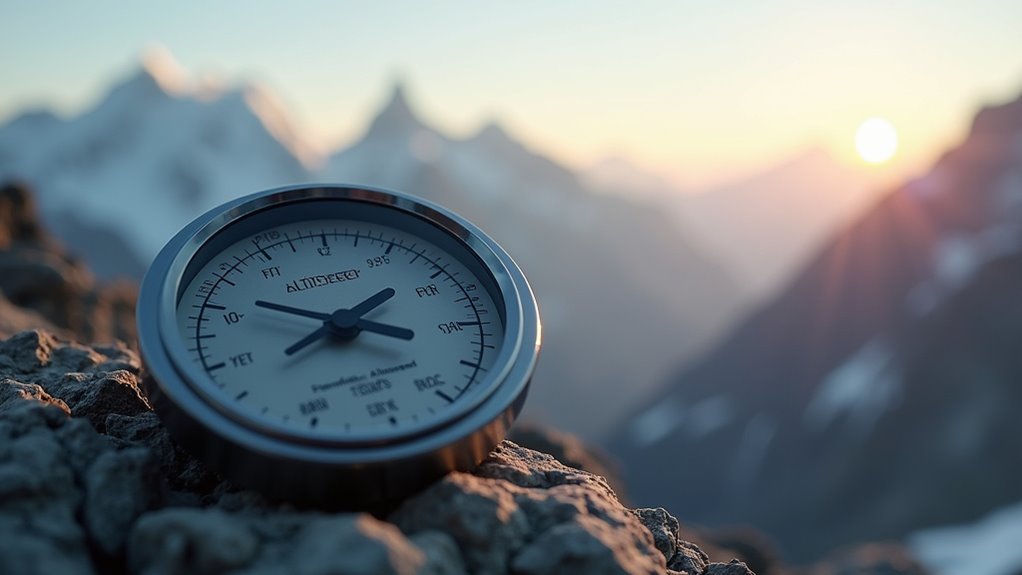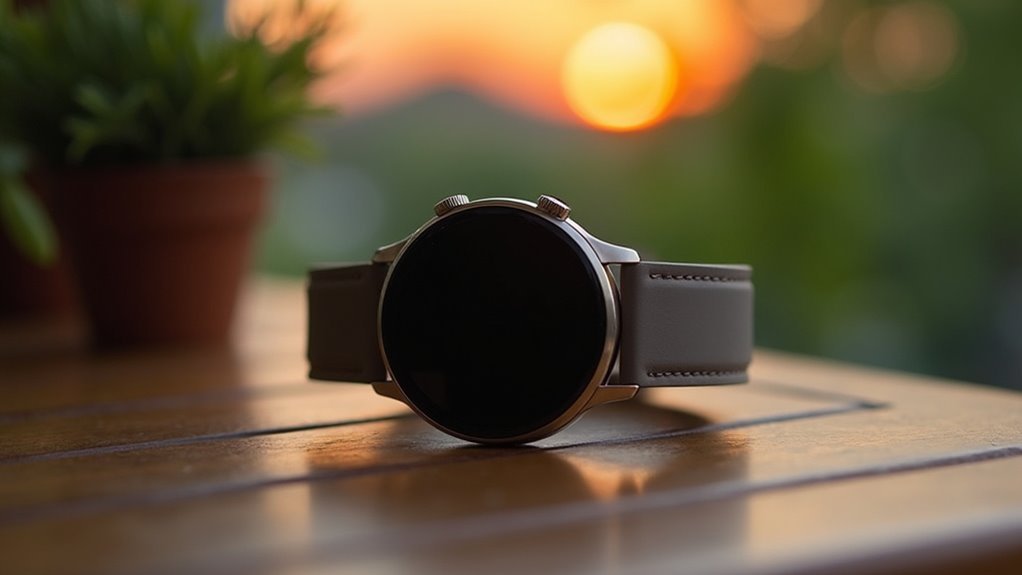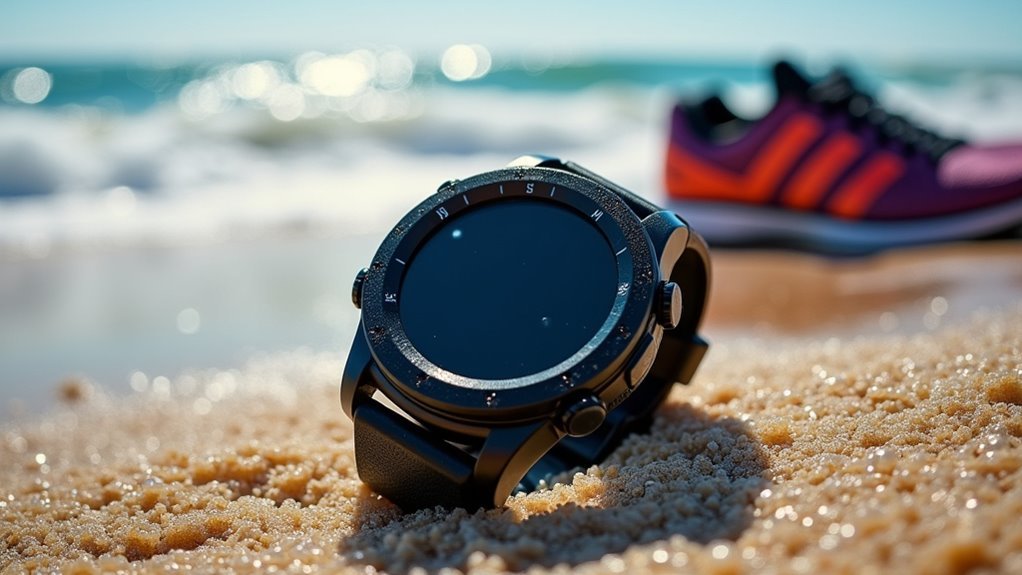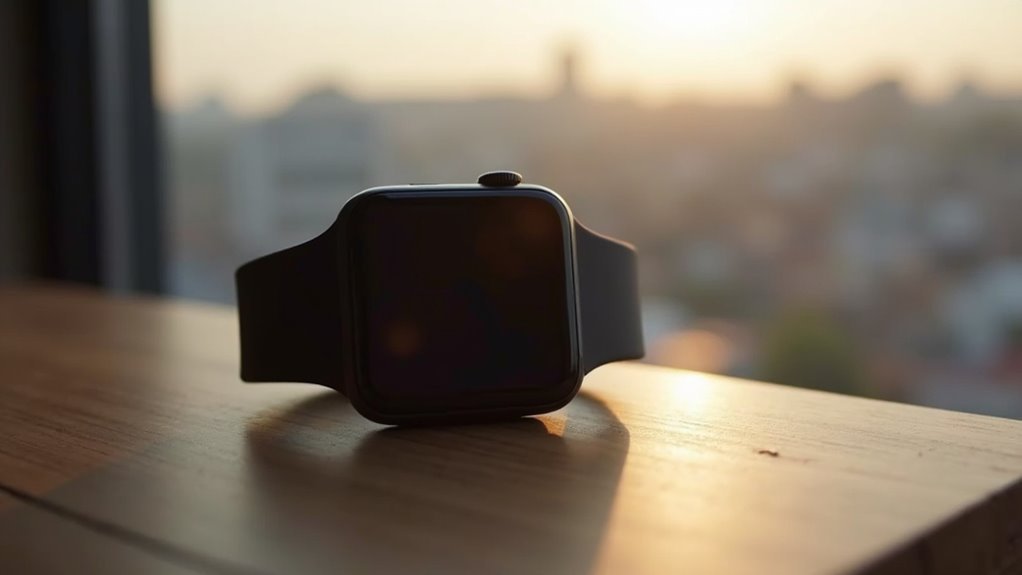You’ll find barometric altimeters deliver superior altitude accuracy because they measure air pressure changes directly, while GPS can vary by hundreds of feet due to signal interference and satellite positioning issues. Barometric sensors respond instantly to elevation changes and work reliably indoors, underground, or in areas where GPS signals struggle to penetrate. They also consume considerably less battery power than GPS systems, making them ideal for continuous monitoring activities. Below, we’ll explore these advantages in greater detail.
Superior Consistency in Real-Time Altitude Tracking

When you’re tracking altitude in real-time, barometric altimeters consistently outperform GPS systems in delivering stable, reliable readings.
GPS altitude accuracy varies considerably, especially when you encounter signal interference or challenging satellite geometry. You’ll notice barometric sensors provide more stable readings in consistent atmospheric conditions, adapting quickly to pressure changes for immediate altitude adjustments.
Barometric sensors deliver consistent altitude readings while GPS accuracy fluctuates due to signal interference and poor satellite positioning.
GPS systems depend on satellite signals that can become inconsistent due to signal blockage or poor satellite positioning, affecting your real-time tracking ability.
Barometric altimeters measure atmospheric pressure directly, creating a more physical connection to altitude that enhances consistency. The aviation industry relies on barometric pressure measurements for altitude determination, with altimeters calibrated to indicate pressure as altitude in standardized units.
While temperature and air pressure changes can affect barometric readings, they’re generally more reliable than GPS for maintaining steady real-time altitude data in stable conditions.
Enhanced Reliability in Signal-Compromised Environments
You’ll find barometric altimeters maintain consistent performance when GPS signals can’t penetrate buildings, tunnels, or dense urban environments where satellite reception fails.
Unlike GPS systems that struggle with signal blockage from terrain and structures, barometric sensors operate independently of external transmission sources. Barometric sensors measure air pressure above the sensor, providing continuous altitude readings regardless of signal interference.
This independence makes them invaluable for indoor navigation systems and underground operations where you can’t rely on satellite connectivity.
GPS Signal Blockage
GPS signals face significant challenges in urban environments where tall buildings create canyons that block or reflect satellite transmissions, leading to degraded positioning accuracy or complete signal loss. You’ll find that dense forests, tunnels, and underground areas create similar problems, interrupting your navigation when you need it most.
| Environment | GPS Performance | Barometric Performance |
|---|---|---|
| Urban Canyons | Blocked/reflected signals | Unaffected operation |
| Dense Forests | Attenuated signals | Continuous readings |
| Underground Areas | Complete signal loss | Full functionality |
Since GPS receivers need signals from at least four satellites, physical obstructions drastically reduce availability. Multipath effects from glass and metal surfaces confuse receivers, increasing positional errors. These interruptions cause delays in logistics, compromise safety during critical maneuvers, and create gaps in tracking data that affect urban planning. The signal environment varies significantly depending on your specific city, location within that city, and even the time of day you’re operating.
Indoor Performance Advantages
Barometric altimeters shine brightest where GPS fails completely—indoors. When you’re inside buildings, GPS signals can’t penetrate walls effectively, causing altitude errors measured in hundreds or thousands of feet.
Your barometric altimeter doesn’t need satellites—it measures atmospheric pressure continuously, providing reliable readings regardless of signal strength.
You’ll find barometric sensors refresh altitude data faster and more frequently than GPS receivers struggling with weak indoor signals. They’re immune to multipath errors caused by signal reflections bouncing off walls and ceilings.
While GPS altitude drifts considerably indoors, your properly calibrated barometric altimeter maintains consistent measurements. Indoor pressure changes occur gradually and predictably, unlike the erratic GPS signal quality that varies with satellite geometry and building interference. The BMP085 sensor delivers readings with approximately 1.7m error accuracy, far superior to indoor GPS performance.
Faster Response Times During Rapid Elevation Changes

When you’re maneuvering through rapid elevation changes, response time becomes the critical factor that separates barometric altitude from GPS in real-world performance.
Barometric sensors track altitude in real-time by detecting instant air pressure changes, providing smooth feedback during climbs or descents without delay. You’ll receive continuous data output that matches your aircraft’s actual movement.
Barometric sensors deliver instant altitude feedback through real-time air pressure detection, ensuring seamless tracking during rapid climbs and descents.
GPS altitude, however, updates at set intervals—typically 1 Hz—creating noticeable lag during sudden elevation changes. You’ll find GPS readings temporarily inaccurate until the next satellite update, with position averaging and signal processing adding further latency.
Flight tests consistently show GPS altitude displaying marked offsets during strong vertical maneuvers, while barometric instruments follow actual movement closely, making them aviation’s industry standard. Air traffic control requires pressure altimeters for compliance with established altitude reporting protocols, ensuring all aircraft maintain consistent altitude references regardless of individual GPS variations.
Better Performance for Relative Height Measurements
During navigation tasks that focus on measuring height differences rather than absolute position, you’ll find barometric altimeters deliver superior accuracy compared to GPS systems.
When you’re tracking elevation changes during hiking, flying, or climbing, barometric sensors respond directly to pressure variations that correlate precisely with height changes.
Here’s why barometric altimeters excel at relative measurements:
- Higher local accuracy – You’ll get precise readings for altitude changes because pressure variations directly reflect height differences.
- Weather reliability – Your measurements remain consistent despite weather conditions, with only atmospheric pressure changes requiring compensation.
- Stable performance – You’ll experience consistent readings due to predictable atmospheric pressure decay patterns. Unlike GPS systems, barometric sensors maintain performance even when satellite geometry changes affect vertical positioning accuracy.
- Minimal calibration needs – Once properly set, your altimeter maintains accuracy over extended periods.
Reduced Dependence on External Signal Quality

Unlike GPS systems that struggle with signal reception in challenging environments, barometric altimeters operate independently of external infrastructure and won’t fail when you’re maneuvering through dense forests, deep canyons, or mountainous terrain.
You’ll experience consistent performance regardless of satellite availability, weather interference, or electronic noise that commonly disrupts GPS signals.
Weather conditions that weaken satellite signals don’t affect barometric readings, though pressure changes require calibration. You’ll get immediate altitude data without signal delays that plague GPS systems in dynamic environments.
Barometric altimeters deliver instant altitude readings unaffected by weather interference that commonly disrupts GPS satellite signals in challenging terrain.
This independence from satellites means you’re never reliant on external resources or additional infrastructure. Whether you’re in urban canyons with weak signals or remote areas with no satellite coverage, your barometric altimeter continues delivering reliable measurements when GPS fails. Advanced watches combine both technologies through FusedAlti™ technology to automatically calibrate and provide the most accurate altitude readings possible.
More Stable Readings During Dynamic Activities
While GPS altitude readings fluctuate and lag during rapid ascents or descents, barometric altimeters deliver consistently stable measurements throughout dynamic activities.
You’ll experience superior precision when barometric sensors respond instantly to pressure changes, while GPS calculations face delays during rapid altitude shifts. Weather conditions that disrupt satellite signals don’t affect barometric readings once you’ve calibrated them properly.
Here’s why barometric altimeters excel during dynamic maneuvers:
- Instant Response – They detect pressure changes immediately without communication delays
- Signal Independence – No reliance on satellite geometry or signal strength
- Smooth Changes – Provide consistent readings during rapid climbs and descents
- Relative Precision – Excel at tracking altitude changes with high sensitivity
GPS altitude can show discrepancies up to 41% under challenging conditions, making barometric measurements essential for critical phases like takeoff and landing. The 100Hz sample rate of barometric sensors provides rapid data collection that captures every pressure variation during flight.
Improved Battery Efficiency in Continuous Monitoring
Beyond delivering stable measurements during challenging conditions, barometric altimeters offer significant power advantages that make them ideal for extended monitoring applications.
You’ll find barometric sensors consume drastically less power than GPS because they rely on passive air pressure measurement instead of active satellite communication.
While GPS watches typically last 4-6 hours to 30 days depending on usage, barometric devices can operate continuously for 2-7 months on standard batteries.
You can monitor elevation 24/7 without frequent recharging since barometric sensors don’t require battery-intensive hardware or processors. Barometric altimeters maintain continuous sampling rates of 20 samples per second without significant power drain.
Hybrid devices maximize efficiency by using barometric sensors for real-time tracking while activating GPS only when you need mapping or navigation, giving you the best of both worlds.
Frequently Asked Questions
How Often Should Barometric Altimeters Be Recalibrated During Flight?
You shouldn’t recalibrate barometric altimeters during flight. Instead, you’ll adjust pressure settings for changing barometric conditions, typically every 100 nautical miles below FL180, following standard changeover procedures.
What Specific Weather Conditions Most Affect Barometric Altitude Accuracy?
Cold temperatures cause your altimeter to overread altitude, creating dangerous low-flying situations. High or low barometric pressure, rapid weather changes, and temperature deviations from standard conditions greatly affect your altimeter’s accuracy.
Can Barometric and GPS Altitude Systems Be Legally Used Together?
You can legally use barometric and GPS altitude systems together in aviation. Dual-system approaches enhance safety through redundant measurements, but you’ll need equipment that meets specific certification standards and regulatory compliance requirements.
What Are the Typical Costs of Barometric Versus GPS Altitude Systems?
You’ll find barometric sensors cost from basic OEM prices to thousands for aviation-grade units. GPS altitude comes embedded in devices ranging under $100 to several thousand for integrated avionics systems.
How Do Pilots Transition Between Different Pressure Settings During Flight?
You’ll switch from QNH below changeover altitude to standard pressure (29.92 inHg) when climbing above transition level. During descent, you’ll change from standard pressure back to local QNH before reaching changeover altitude.
In Summary
You’ll find barometric altitude gives you the edge when you need reliable, real-time elevation data. While GPS struggles in challenging environments, you’re getting consistent readings that respond instantly to elevation changes. You won’t deal with signal dropouts, and you’ll enjoy better battery life during extended monitoring. When you’re tracking dynamic activities or need precise relative measurements, barometric sensors deliver the stability and accuracy you can’t get from GPS alone.





Leave a Reply